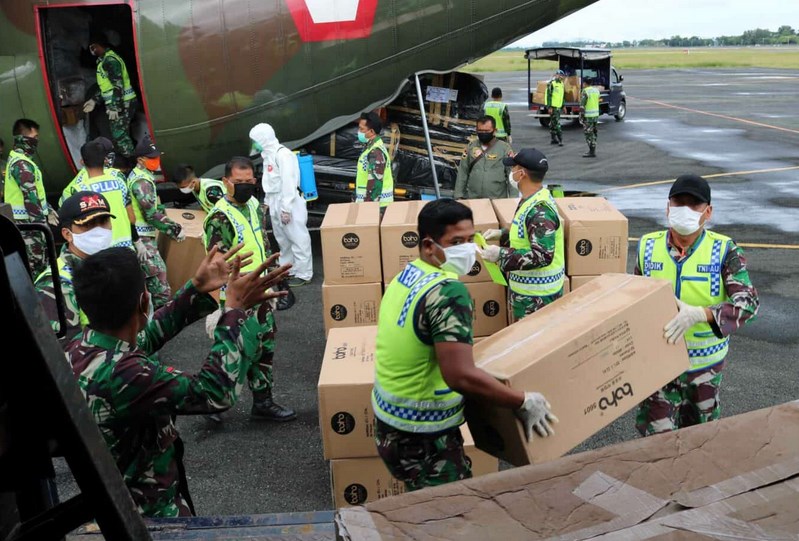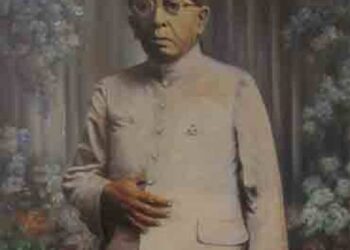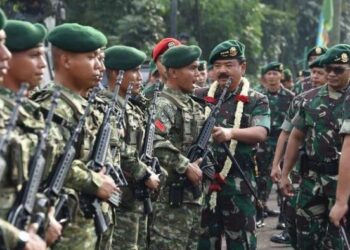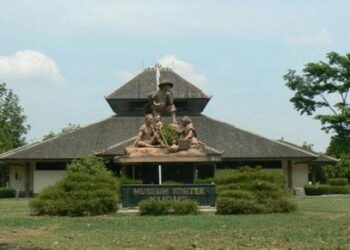Handling logistics by the Armed Forces of Republic Indonesia
The logistical sense that if we talk about ABRI leadership we can’t ignore the logistical problems. As has been said from the beginning, one of the functions of leadership is to pay attention to the well-being of those who are led. Welfare management including logistics functions. But the logistics function is much broader than welfare management. Leadership cannot be implemented properly without logistical support.
Indonesia has only known the notion of logistics since the 1950s, as outlined in the first chapter, the understanding of new leadership we have known since TNI officers attended military education in the US in 1951. Similarly, the sense of logistics we have only gained since that time. The Dutch army in the days before the second world war had not used any logistical understanding. It was only in the second world war when the Dutch army had to move alongside British troops in Europe and US troops in the Pacific region, they used that notion. Therefore, the Dutch army that has been the Dutch Military Mission in Indonesia since 1950 has used the understanding of logistics.
It turns out that also in the U.S. military environment the sense of logistics is relatively new. According to Richard M Leighton in encyclopedia Americana, it was not until 1944 that the notion of logistics was officially included in the US military dictionary, although that notion was already used before the Second World War by staff officers for military planning.
Initially, the understanding of logistics was used in the sense of military supplies and transport. However, since 1949 the understanding has expanded and includes all activities related to the handling of military equipment (including its production and procurement) as well as all activities related to military personnel. (including training) as well as the construction and maintenance of military facilities. Thus logistics is the same as the understanding of the administration, all activities do not include strategy or tactics.
There is a difference between consumer logistics, namely the supply of troops in the field, and production logistics, namely the production and procurement of war equipment. There is also a sense of the logistics of the communication line, namely the transport from the national base to the war zone. Meanwhile, the logistics of the battle concern supplies in the field of war. In general, people use the logistics sense more in a narrow sense — the same logistics as the military administration as a whole. In that case, the logistics are the same as the military administration as a whole. In that case, logistics is interpreted as an attempt to carry or transport the right items, in the right amount, at the right time, for the right person or party or who needs it.
When the military organization was still simple, i.e. before the 19th century, logistics had no significance. At that time the battle was carried out mainly using individual weapons. Even if it has been used with a cannon then it is still limited until the transport of the engine is fully a concern of the artillery unity itself. Food for the troops is often obtained by depriving the residents of newly captured areas of food. So the troops move relatively lightly without carrying supplies. Brau after the influence of technology is increasingly felt in the implementation of war and battle. Logistics is a real and even urgent need, individual weapons are not the lag of weapons whose machines must be inserted from the face of the barrel, but rather there are already technologies that allow making bullets. It consists of projectiles and explosive devices in one wholeness bound by cladding. And bullets can be tethered from the back by inserting bullets in the room. Since then it has become known that rifle re-fire can be fired much faster and often than ever before. That in itself greatly increases the firepower of the troops. Finally, the use of gunpowder for individual soldiers is greatly increased and it can no longer be met only with gunpowder carried by individual soldiers.
Read also :
TNI Logistics Handling – ABRI Leadership Book
TNI Leadership In History And Struggle – Book Reviews
The Difference of Opinion on TNI – Summary of ABRI Leadership Book
The Role of TNI in National Development – Summary of ABRI Leadership Book
Logistics Implementation System
In order to be able to carry out logistics in a manner must be used systematic and orderly implementation. Especially for one soldier whose country is less able to carry out production so that in many ways depending on the production of another country, there are many problems that all should be able to be solved systematically.
Not many countries have the ability to produce food and equipment, including complete weapons systems. Because of the importance of logistics, the NAZIS under Adolf Hitler attempted to create an autarki — a fully independent economic system without being dependent on foreign affairs.
Because the production of each country has limitations, some are large and some are small, so the implementation of logistics always has difficulty. At first the unity was equipped with food supplies and gunpowder to each person brought by themselves. Because the amount carried is limited, then after exhausted must be added. The additional niasanya was obtained from the area the army was in. When the ability of angku increases with the absence of a separate vehicle in addition to supplies also carried by the unit in its vehicle. Starting to have the formation of units Although there have been a lot of supplies brought in, but there is still a limit Then it is also necessary to increase this supply by taking from the army the area is opinionated, when the supplies are beginning to be taken out. This way is called self-help logistics.
The army that most actively ran independent logistics by generating high combat power was Genghins Khan’s army in the 13th century. If there is no need to fight with horseback riding or kaveleri Genghins Khan herds cattle for that purpose along with a group of horse-drawn carriages transporting supplies and equipment. Travel routes and camping sites are planned well in advance so that there is a possibility of feeding the cattle brought in as well as to increase feeding for the troops. However, if there was a need for the supplies to be abandoned and the cavalry quickly galvanized the enemy from various directions the mongl army could travel about 290 kilometers in less than three days , a very high mobility capability for that time.
However, since the 17th century the independence of the army has been reduced. That’s because the size of the army is getting bigger. So it is difficult to add depleted supplies by taking the drai operating area. It was seen once in Napoleon’s operations in Russia and Spain. From the 19th century it could be noted that logistics had to be arranged from the back to the leading forces.
In the logistics system it is known the back area, the communication area and the combat area. In the back area there is a place of production that produces a wide range of food and beverage items that are always, named grade I items. Then also gasoline and lubricating oil that must exist after motor vehicles become an important part in the army, named class III items. Besides, there is also a very important variety of bullets and gunpowder called class IV items.
Logistics of the Armed Forces of Republic Indonesia
Logistics has been an issue for ABRI since its int outing, although in 1945 we are not familiar with the word logistics. Since its establishment every BKR organization has had to work on at least food for its members and gunpowder for the weapons used. At that time people became members of BKR carrying their own clothes and had not been wearing uniforms. Some even carry their own weapons obtained in various ways. At that time a commander and his members were running independent logistics, so could not expect any supplies from other organizations at all.
Looking to the Future
At the end of the 20th century and in the 21st century mankind is in a state that pays great attention to brain activity, especially the left brain, which concerns human thinking activities. Due to the widespread increase in public education and the longer it reaches all parts of humanity, then humans tend to use their thinking skills more than ever before. By being pioneered by the part of the manuasia people who have advanced in the ability to think, then the manuasia people are more and more widespread and also more in its development in science.
The development of science gained significant deepening, because developed nations saw the importance of increasing efforts to understand the life of the universe. Humans are getting deeper into the various realities of life that they didn’t know – such as the state of outer space or molecular life. Also, science that was previously known to be in the deep and produce special skills in that science. People are becoming more and more deeply knowledgeed about things that are getting narrower. One could say the life of the nodern century is the century of specialist life. But then it was also suggested that specialization could not provide a complete knowledge of the life of the universe. So there is also an effort to see all aspects of life as a wholeness, or so-called holistic approach. The development of specialization and holistic knowledge creates a very strong dynamic in the life of mankind.
Then each army seeks to strengthen itself by using more weaponry and greater firepower. Because the source of weaponry is only a weapon from one particular area owned by the japanese army., where there is an effort so that the leadership of the local Japanese army will be able to carry the weapons of all its troops, while the troop’s mileage is not worth the amount of anggtanya. Re- RA managed to create a more stable TNI condition just before the Dutch conducted the offensive which became the opening of the second war of independence in August 1948.
As an overview of the logistical condition of ABRI during the period 1945 – 1948 the situation in the military academy in jogjakarta can be given as an example. Although the Military Academy was formed at the decision of the Army Headquarters (MBT) as the leadership center of the TKR, the equipment and supplies for the largest part had to be attempted by the AM leadership itself.
National Logistics
In the time of the Old Order and previously there was no thought and implementation of national logistics. At that time the understanding of logistics was a military concept carried out onleh ABRI.
However, when entering the New Order and the role of ABRI officers increased in the maintenance of national management, it was seen as a necessity to bring logistical understanding also into the non-ABRI company. It mainly concerns the government’s need to maintain national stability. In national stability there needs to be maintenance or stability of supplies in the community called nine staples.
Therefore, the Government of The Republic of Indonesia under general Suharto then in 1966 established the National Logistics Command which functioned to manage the supply of the people in nine staples, especially sugar and wheat rice. However, some disagree with the name of the National Logistics Command ,because it is considered with the opposition of the constitution. Therefore, it is then taken another name, namely Logistics Affairs Agency or BULOG. In the first phase BULOG was in the spotlight and sometimes even sharp criticism from civil experts who saw bulog as an excessive organization and made the government too interfering with the economic path and public life.
Read also :
TNI Logistics Handling – ABRI Leadership Book
TNI Leadership In History And Struggle – Book Reviews
The Difference of Opinion on TNI – Summary of ABRI Leadership Book
The Role of TNI in National Development – Summary of ABRI Leadership Book
BIBLIOGRAPHY
1. Sejarah Militer, ringkasan buku “Kepemimpinan Abri Dalam Sejarah Dan Perjuangan” halaman 246-297.
















